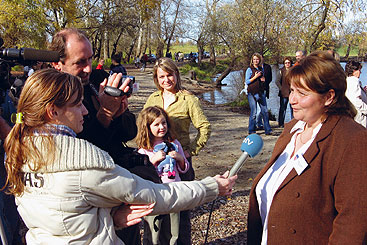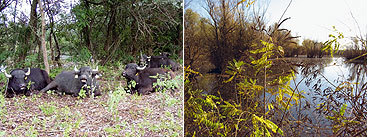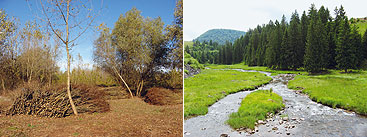
Good for people, business, nature – successes from along the Tisza
Four years ago Danube Watch reported on WWF’s plans for harmonising economic development with environmental improvements through its then new programme One Europe, More Nature. Promising ‘new perspectives for the Tisza river basin’, the initiative has delivered new jobs, new income, new business, new products and services, new green electricity – and new nature.

Local and national media has highlighted again and again the innovative actions taking place in Tiszatarján.
Business from, and business for, nature. That was the philosophy behind WWF’s flagship economy/ecology programme One Europe, More Nature (OEMN). In practice this meant seeking out unusual partnerships, investigating new possibilities, understanding stakeholder motivations and piecing together a business/ nature mechanism which would work to the benefit of all. Two project locations in the Danube River Basin perfectly epitomise this innovative approach: the Tisza floodplains near Tiszatarján in eastern Hungary, and the Oas-Gutai plateau near Baia Mare in Maramures in northern Romania. Six years after kicking off, real progress has been made on all fronts, and opportunities are now ripe for further investment to scale up the businesses and deliver more jobs, more income and more nature.
Green electricity from, and for, nature. The Tisza floodplains in Hungary are dominated in many places by the aggressive, invasive, detrimental shrub Amorpha fructicosa (False Indigo). This plant is bad for biodiversity and bad for flood management, and extremely unpopular as a result. It has colonised thousands of hectares along the Tisza, even as far as the Danube Delta in Ukraine. Seeking an economic mechanism to drive floodplain restoration, WWF persuaded a power station company, AES Hungary, to carry out burning tests on the shrub to see if it had potential as biomass for green electricity generation. It did.
Next, WWF worked with local communities along the Tisza to develop an ambitious landscape and economic vision for the region, featuring the restoration of the typical Tisza landscape of woody grasslands, wetlands and floodplain forests. The municipal local government of Tiszatarján, together with private landowners, proved to be willing and energetic partners.
The Amorpha is cut by local workers, bundled up and transported to a nearby AES power station where it is sold and then burnt as biomass for renewable electricity generation. On the cleared floodplain, two new land ‘uses’ are initiated: on one part, grassland and wetland restoration takes place, using some of the biomass sales revenue. Here, nature returns. On the other, less suitable land, fast-growing (native) willow trees are planted, which also yield profit on a three-year cycle when transported and sold to the power station. The willow transforms this mechanism from a ‘oneoff’ economic and ecological boon, into a sustainable cycle of Amorpha clearance, nature restoration and green energy production – guaranteeing that as many as possible of the 40 new jobs are kept, long into the future.
Simple, and effective. On the land and water given back to nature, three indigenous animals which long ago disappeared from this region have been reintroduced. Beavers, hunted out of central Europe in the 19th centur, were last year released into the wild and can now be seen working as nature’s “wetland hydrologists”. Nearby, a herd of Hungarian long-horned grey cattle plays a similarly positive role on the newly exposed grassland. Water buffalos, brought into the Carpathian basin a thousand years ago, have also been released into the wetter grassland areas to do the same. All three animals are directly re-building the ecosystems damaged by the Amorpha invasion. More than that, the cattle and buffalo have an additional role to play in that they eat the shoots of young Amorpha plants, and thus prevent the jungle from returning. “We are happy to be rid of the Amorpha jungle, and are proud of the new landscape taking shape,” explains Mrs. Lajos Bögrené, mayor of Tiszatarján. “The jobs and money are much needed here, and on the restored natural areas, new economic opportunities such as animal husbandry, and eventually rural tourism, are beginning to become a reality.”

Water buffalos have been
re-introduced to graze
the cleared areas, keeping
new Amorpha shoots
at bay and gradually
restoring the species-rich
composition.
Wetlands like these
perform valuable flood
management roles as well
as being perfect habitats
for biodiversity.
High quality food from, and for, nature. Upstream, in the headwaters of the Tisza in Maramures, an entirely different mechanism is yielding similarly positive results. Here the goal for WWF was the conservation – rather than restoration – of priceless natural capital. But the goal for local landowners and businesses was the same: income diversification, jobs, profits.
The species-rich upland meadows of the Oas-Gutai plateau risk turning into shrub as a result of land abandonment driven by EU accession and the restructuring of agriculture. This would not only hit the plateau’s abundant biodiversity, but also degrade the mosaic landscape of mixed woodland, grassland and wetland which is so attractive to tourists. So OEMN staff assisted governmental authorities to designate more than 19,000 hectares as a Natura 2000 area.
Then, together with a local landowner/entrepreneur family in Ocna Sugatag, WWF assisted an integrated tourism and cattle business up on the plateau. Featuring Romania’s first organic beef herd and a rustic tourist cabana, the business produces healthy, high quality beef products and also offers visitors a unique high-altitude tourism experience. The cows graze the meadows and maintain the natural ecological balance, and a special winter shelter has been built from local materials to enable the cows to stay year-round, even through the long Maramures winters. And prime nature-friendly beef products will soon be available in the guesthouses, restaurants, hotels and organic food shops, not just in Maramures but also further afield. New arrangements are now being worked out with slaughterhouses, butchers and distributors to make the beef available across the country.
“There are many challenges in developing such a green business,” explains Mrs Rodica Tiplea, whose family has invested heavily in this new scheme. “But we believe we will succeed, the animals are multiplying before our very eyes, and we are heartened by the appreciation of our visitors and customers, all of whom now know that what is good for nature, can also be good for business.” Soon, the Tiplea family will give back to WWF the same number of cows as they originally received, and these will then go to another business on another part of the plateau. In this way, the mechanism spreads, as do the benefits.

Cutting the Amorpha
reveals the basis for
restoring the species-rich
grassland so typical of the
Tisza floodplains.
The majestic Maramures
landscape is valued by
tourists but needs to be
maintained to ensure that
its mosaic quality remains.
Green business, green investments, a green future. The success of these projects is relatively modest in size right now, but they are just the beginning. Each has significant potential for expansion or replication. Each is on the cusp of financial, commercial viability. Each is ripe for investment.
“OEMN demonstrates clearly that business and nature can co-exist, and that one can be built from the other and vice versa,” concludes Dr Lifeng Li, Director of Freshwater for WWF International. “We predict that the green economy will continue to expand throughout the next decades, and so businesses already on this track will have a huge competitive advantage. What’s more, companies and communities who are actively safeguarding their natural capital – especially water and energy – will find that ever more useful, as society faces up to the challenges presented by climate change.”
Certainly, the ‘new perspectives’ promised by this project four years ago have become a reality, and now the participating communities and companies can face the future with strengthened optimism. When nature returns, all sorts of opportunities spring up.
For more information, please visit:
www.panda.org/europe/oemn.
Disclaimer
The information contained in the ICPDR website is intended to enhance public access to information about the ICPDR and the Danube River. The information is correct to the best of the knowledge of the ICPDR Secretariat. If errors are brought to our attention we will try to correct them.
The ICPDR, expert group members, nor other parties involved in preparation of information contained on this website cannot, however, be held responsible for the correctness and validity of the data and information provided, nor accept responsibility or liability for damages or losses arising directly or indirectly from the use of the information conveyed therein.
Only those documents clearly marked ICPDR documents reflect the position of the ICPDR.
Any links to other websites are provided for your convenience only. The ICPDR does not accept any responsibility for the accuracy, availability, or appropriateness to the user's purposes, of any information or services on any other website.
When using the information and material provided on this website, credit should be given to the ICPDR.
